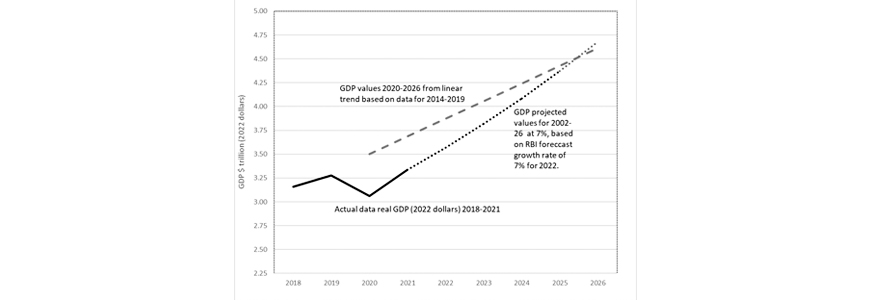Recently, the Indian economy has been hurt by two shocks that did not originate in India. The first shock came in 2020 from Covid. The second shock has come from the rise of interest rates in the US. In this note, we analyze the impact of these shocks, and find that the economic damage is significant and ongoing. We then recommend a significant increase in the number of production-oriented entities as a way of helping the Indian economy to become less vulnerable to such shocks.
The Covid-19 shock is still hurting the economy
The Indian economy had negative GDP growth (-6.60%) in 2020 due to Covid. There was recovery in 2021 (GDP growth of 8.95%)? Does it mean that we have overcome the damage done by Covid? No – the economy is still hurting.
The reason is that we lost more than 6.60% of the GDP in 2020, which was the measured loss. To this, we must add the increase in GDP that did not happen due to Covid. Say that without Covid, the GDP would have gone up by 5%. Then, our real loss due to Covid in 2020 is 6.60 + 5.00 = 11.60%. With a gain of 8.95% in 2021, we have not yet fully recovered.
More importantly, Covid has pushed India onto a lower growth path. We can see this in Figure 1, which has three lines.
- The solid line shows the actual GDP for 2018-2021 in 2022 dollars.
- The dotted line shows the projected GDP for 2022-2026. The growth rate is 7%, predicted by the RBI for 2022 and applied to future years also.
- The dashed line shows the trend GDP for 2020-2026. This is what would have happened if
(i) Covid had not happened, and (ii) we had followed the 2014-2019 trend.
Figure 1: India's actual, projected and trend GDP (2022$)

Data source: World Bank.
The trend-projected GDP is higher than the 7%-growth GDP over 2020-2025, and India will stop losing due to Covid in about 2026. The total GDP loss over 2020-2025 is about US$ 1.5 trillion, or about 45% of the GDP in 2019. That's a huge loss.
Adverse impact of second shock
The loss of about $1.5 trillion is based on a GDP growth of 7% for four years. This is unlikely because of the rising US interest rates, which have led to a declining rupee and turmoil in international financial markets. The Union Chief Economic Adviser said in October 2022 that this turmoil has created external headwinds that will slow down the Indian economy. So, a growth rate of 7% is a best-case, not probable-case, scenario. The World Bank and the IMF have already cut their forecasts for India to below 7%.
At the World Bank growth rate of 6.5%, the total loss over 2020-2025 increases from about $1.5 trillion to about $1.75 trillion, which is about 53% of the 2019 GDP. The value of the loss varies depending upon the assumed rates, but there is no doubt the Indian economy is still being hurt by both shocks.
Way forward
We need to make the Indian economy more resilient to such shocks. And we need to create more reasonably paying jobs for the many young people coming of working age.
In India, it is normal to ask governments to do more. But it is now clear that government efforts need support from non-profit entities who help to increase the production of private producers. Amul and SEWA, formed long ago, have shown us what non-profit entities can do to help producers. The Union government is setting up Farmers Producers Organizations – a good idea.
Further, the Union and State governments have several schemes to help Medium, Small, and Micro Enterprises (MSMEs). But too many MSMEs are still struggling. They badly need support from non-profit entities. This support would help them take full advantage of government schemes. Further, the non-profit entities would provide narrowly targeted help, in contrast to government schemes, which cover a broad section of firms across the State or the whole country.
Why should anyone support MSME?
MSMEs need less investment in their production process than large firms and would not depend on foreign firms. Further, they are Indian companies, in contrast to several large firms which are sometimes foreign. Further, most MSMEs provide goods and services mainly to the Indian market and would often use local inputs. This makes them less vulnerable to international shocks.
However, many MSMEs did suffer from Covid. Support from capable non-profit entities would help many of them to do better in future shocks.
India does not have many non-profit entities of the type described above. It will take a combination of experienced people and younger energetic people to form and operate these entities. Fortunately, India does have enough motivated and talented people who can do this. It's time for them to come together!
About the Author
Subodh Mathur, an economist (Ph. D. MIT), has worked in many countries. He is the author of the book called ‘India's Path to Prosperity 2022-2047: A Workable Agenda for the Next 10-15 Years’.